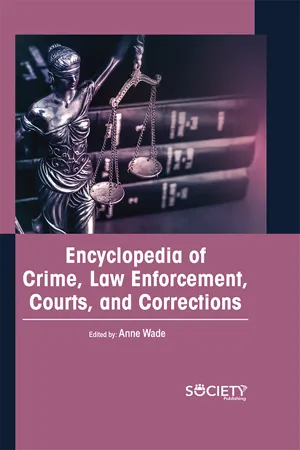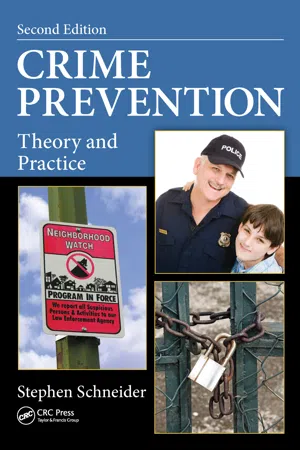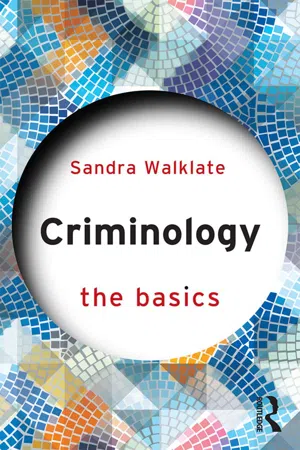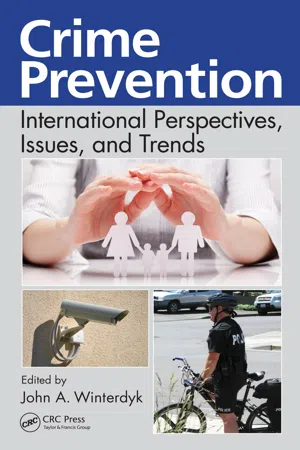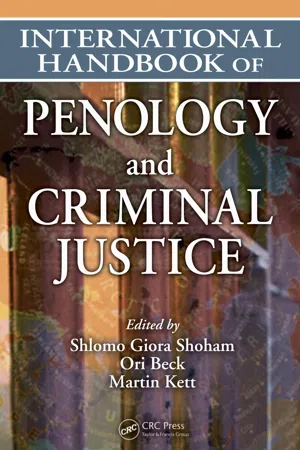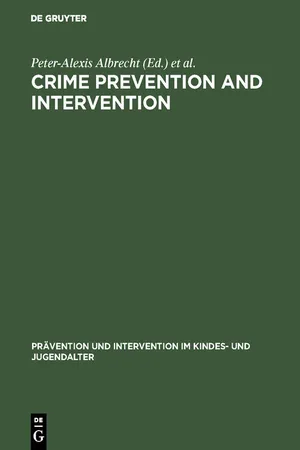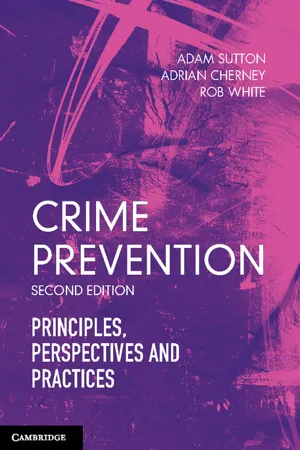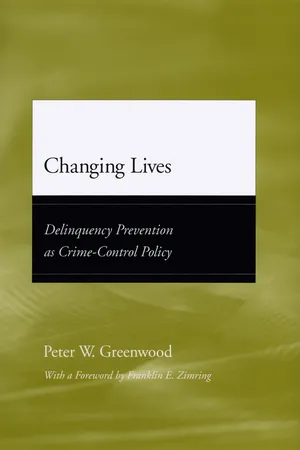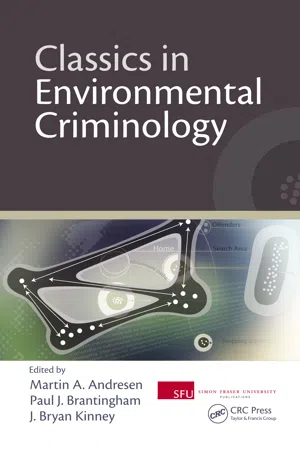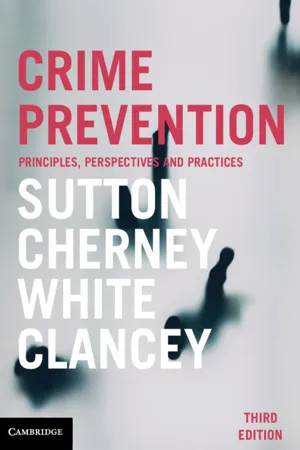Social Sciences
Crime Prevention
Crime prevention refers to the strategies and measures aimed at reducing the likelihood of criminal activities occurring within a community or society. This can include initiatives such as community policing, public education, environmental design, and rehabilitation programs for offenders. The goal of crime prevention is to create safer environments and reduce the impact of criminal behavior on individuals and communities.
Written by Perlego with AI-assistance
Related key terms
1 of 5
12 Key excerpts on "Crime Prevention"
- Anne Wade(Author)
- 2023(Publication Date)
- Society Publishing(Publisher)
It also provides the rationale for further investigation procedures (Seltzer, 2005). Crime Prevention strategies are developed and implemented by law enforcement agencies, local municipalities, non-profit organizations, and businesses of all types in order to protect the community from the negative effects of crime. A primary objective of Crime Prevention is reducing crime rates. Crime Prevention Strategies 113 Criminologists define crime as an act that violates a law and is punishable by the criminal justice system. The punishment could range from a fine to death. However, it’s important to remember that people don’t just commit crimes because they feel like it; there are usually larger factors at play, such as past trauma or feelings of hopelessness. A person’s environment and personality can also determine whether they are more likely to commit a crime than someone else. There are many different types of crimes, but some common ones include property crimes (burglaries, vandalism), violent crimes (assault, murder), white-collar crimes (money laundering), and organized crime (human trafficking). Crime Prevention focuses on preventing these acts before they happen as opposed to rehabilitating offenders after the fact (Figure 5.2) Figure 5.2. Crime Prevention involves the incorporation of a number of agen- cies and bodies including the community and the environment. Source: Image by The Shoreline Beacon. Crime Prevention strategies are a set of actions designed to reduce the likelihood of criminals and victims of crime. Examples include keeping an eye out for warning signs and making personal changes, such as locking doors and closing windows at night. A Crime Prevention policy may include strategies for reducing the potential for crime by enhancing community safety, neighborhood security and cultural or social issues (Redondo et al., 2020).- eBook - PDF
Crime Prevention
Theory and Practice, Second Edition
- Stephen Schneider(Author)
- 2014(Publication Date)
- Routledge(Publisher)
One weakness of this definition is that not all Crime Prevention strategies focus on the causes of crime: SCP, for example, attempts to limit the opportunity for a crime to occur in a particular time and place. Lab (2004, 23) defines Crime Prevention as “any action designed to reduce the actual level of crime and/or perceived fear of crime.” Like others, this definition is quite vague and could apply to any effort to address crime or the fear thereof, especially given that it does not appear to emphasize the proactive nature of Crime Prevention. For Sherman et al. (2006, 3–4), Crime Prevention should be defined not by intentions , but rather by its consequences . That is, the actual approach is not as important as the results; if a strategy or program has served to prevent a criminal act from occurring or criminal behavior from emerging, it should be classified as such. These outcomes can be defined in a number of ways: a reduction in or prevention of specific criminal events; a reduction in the number of criminal offenders, the extent to which harm was Theory and Practice of Crime Prevention 7 prevented or reduced; or a reduction in the number of victims harmed. The strength of this characterization is that it focuses primarily on results: the prevention of crime and criminal behavior. By defining this concept through results, a broad universe of approaches can potentially be included, from working with at-risk children to incarcer-ating chronic adult offenders. Yet, this inclusiveness can also be viewed as a potential weakness because it ensures that the concept of Crime Prevention remains vague and ill defined. If you measure Crime Prevention by the outcome of interventions, you can include almost any crime control tactic under this definition (including the traditional criminal justice approach of cops, courts, and corrections). - eBook - PDF
Psychology and Crime
2nd edition
- Aidan Sammons, David Putwain(Authors)
- 2018(Publication Date)
- Routledge(Publisher)
129 Crime Prevention C H A P T E R 10 The goal of Crime Prevention is to reduce the amount of criminal activity and the harm that it causes along with the number of criminal offenders and their victims. Crime Prevention strategies are used by individuals, communities, businesses and government to target those factors that are known to cause crime in order to facili-tate a reduction in crime. This chapter surveys some of the ways in which psychol-ogy can contribute to reducing crime. It starts by distinguishing between different types of Crime Prevention and then discusses how crime can be prevented by alter-ing the environment, intervening with people at risk of involvement in criminal activity and by helping to rehabilitate offenders. Approaches to Crime Prevention The Public Health Model is an approach to Crime Prevention adopted from the med-ical profession. The medical approach to, for example, heart disease is not solely based on emergency procedures that occur once someone has already had a heart attack, but on ways in which people can reduce their risk of developing heart dis-ease in the first place (e.g. adopting a healthy lifestyle). In the Public Health Model of Crime Prevention there are three interrelated and coordinated approaches for reducing the seriousness and incidence of criminal behaviour: primary, secondary and tertiary (Mackey, 2012). Primary and secondary preventions are forms of deter-rence; they try to encourage people not to commit an offence. Tertiary prevention aims to reform offenders so that they do not reoffend (see Chapter 9). Primary Crime Prevention refers to proactive attempts to prevent crime before it happens. These include strengthening resiliency factors that help individuals to avoid criminal behaviours, and reducing risk factors that increase the likelihood of criminal behaviour. - No longer available |Learn more
Criminology
The Basics
- Sandra Walklate(Author)
- 2016(Publication Date)
- Taylor & Francis(Publisher)
In this chapter we shall consider the key trends in Crime Prevention that have occurred over the last 30 years and we shall explore their links with different strands of criminological thought. More importantly, however, this chapter will be just as concerned with demonstrating what has been made visible and invisible within these trends. In other words, the reader will be asked to think about what kinds of crimes policy trends have paid attention to and why. However, first of all, it is important to say something about what is assumed by the idea of Crime Prevention.WHAT DOES PREVENTION MEAN?
In general terms, ‘prevention’ is taken to be a ‘good thing’. Whether with respect to health, poverty, or crime, prevention is assumed to be a good thing because social problems are seen to be bad things. However, in any context, understanding prevention involves two connected processes; being able to predict the outcome of a chain of events, and then being able to devise a way of intervening with, or altering that predicted outcome. Within criminology Crime Prevention implies that we can identify the cause of crime and on the basis of this devise policies that can stop crime from happening. (For those of you who have managed to make it this far through this book, you should already be aware of what a tall order this is!) The ever changing nature of crime, and the ways in which it is committed, indicate how complicated a relationship this may be. Nevertheless, policy makers and politicians, sometimes informed by criminologists sometimes not, spend a good deal of time being preoccupied with Crime Prevention. In recent years, however, it has become more popular to talk of crime reduction and/or community safety, or even the notion of resilient communities. This change in terminology sends out the message that the possibility of preventing crime is less likely than reducing it or managing it better as a social problem, in order to make people feel better about crime. The reader will undoubtedly make up his or her own mind on whether this is likely to be the case.As this chapter unfolds it will become clear that there are different ways in which Crime Prevention is understood and subsequently acted upon. Ken Pease (2002), an internationally recognised criminologist who has frequently worked within the Crime Prevention area, argues that there are three broad approaches to the cause of crime. We have used his terms earlier in this book but to reiterate them here they are: psyche, opportunity and structure. These terms all articulate different ways of thinking about how to proceed with Crime Prevention (reduction). - eBook - PDF
Criminology NQF3 SB
TVET FIRST
- M Schoeman(Author)
- 2013(Publication Date)
- Macmillan(Publisher)
Topic 6 The effectiveness of different strategies and programmes to reduce or prevent crime and victimisation 140 Topic 6: The effectiveness of different strategies and programmes to reduce or prevent crime and victimisation Crime reduction or prevention strategies and programmes Overview At the end of this Module, you should be able to: • debate the different definitions of crime reduction or prevention • distinguish between models, strategies and programmes • evaluate the effectiveness of specific crime reduction or prevention strategies and programmes to deal with specific types of crime. Introduction Crime Prevention is any initiative or policy that aims to reduce or eliminate crime and victimisation. It includes Government and community-based programmes that aim to reduce risk factors that could cause criminal behaviour and victimisation. Criminologists such as Gottfredson, McKenzie, Eck, Farrington, Sherman, Waller and others have been at the forefront of analysing what works to prevent crime. In this Module, the various definitions of Crime Prevention will be discussed, a distinction will be made between a model, strategy and programme, and the effectiveness of various Crime Prevention strategies will be discussed. Unit 16.1: Different definitions of crime reduction or prevention There are several definitions of Crime Prevention. Some of these definitions distinguish between Crime Prevention and crime control, while others follow a more comprehensive approach. Having said this, there is no generally accepted definition for Crime Prevention. Tuck defines Crime Prevention as ‘all actions aimed at preventing crime that do not include the criminal justice system’. It can therefore be interpreted as the measures that authorities, communities, businesses, and individuals take to prevent crime. Crime Prevention activities aim to address the crime problem by means of educational campaigns and socio-economic upliftment of people’s socio-economic situations. - eBook - ePub
Crime Prevention
International Perspectives, Issues, and Trends
- John A. Winterdyk(Author)
- 2017(Publication Date)
- Routledge(Publisher)
8Social Crime Prevention
Concepts, Developments, and Challenges MATJAž AMBROž GORAZD MEšKO BENJAMIN FLANDERContents
Introduction Defining and Conceptualizing SCP The Historical Context: A Brief Sketch of the Key Post-War Developments in SCP The Social Root Causes of Crime and SCP Measures of SCP Problems and Evaluation Summary Glossary of Key Terms Discussion Questions Suggested Reading Recommended Web Links References Learning Outcomes After reading this chapter, you should be able to understand the- Concept of social Crime Prevention
- Key developments in social Crime Prevention
- Role of root causes of crime in planning for social prevention
- Importance of preventive activities that depend on inclusive social policy (family support, education, employment, etc.)
- Challenges for the concept of social Crime Prevention in times of globalization, individualization, and neo-liberalism
Introduction
What all this means is that real social Crime Prevention, like the prevention of other social ills, is now more than ever dependent on our capacity to build … movements for social action and social change. These … should be committed to the long-rage effort to replace a society based increasingly on the least inspiring of human values with one based on the principles of social solidarity and contributive justice.E. Currie 1996, p. 354Social Crime Prevention (SCP) can be linked to the social control theory of crime (Hirschi 1969), which asserts that the strength and durability of an individual’s bonds or commitments to society serve to diminish his or her propensity for deviant behavior. Unlike the more traditional example of situational Crime Prevention (Clarke 1996; Jeffery 1971; Newman 1972; also see Chapter 14 in this volume), SCP is based on an assumption that real changes regarding diminishing deviancy and crime rates can be achieved mainly through solving social problems, such as social inequality, a low educational level, structural unemployment, poor employment opportunities, discrimination, poverty, and social exclusion (Meško 2002). Attempting to achieve its goals, SCP is concerned with measures aimed at tackling the root causes of crime and the predisposition of individuals to offend (Crawford and Traynor 2012; Graham and Bennet 1995). SCP programs and initiatives focus on individuals, groups and communities, and (potential) victims of crime (Meško 2002). Such programs minimize the risk for individuals, be they (potential) offenders or victims of crime, and contribute to the reinforcement of resilient communities. Usually, adherents of SCP criticize other preventive approaches and programs for wrongly addressing the root causes of crime while dealing only with its symptoms (see Box 8.1 - Shlomo Giora Shoham, Ori Beck, Martin Kett(Authors)
- 2007(Publication Date)
- Routledge(Publisher)
Unfortunately, most people expect immediate improvements. Impatience is antithetical to social prevention. Third, some critics reject social prevention because of its utopian appearance (Gilling 1994). Many people believe that crime and disorder are an integral part of modern society, and all we should expect is to contain the problem. Fourth, there remains a great deal of ambiguity over whether making the large social changes will greatly improve the crime problem. This uncertainty comes from the lack of agreement over the underlying causes of crime (Gilling 1994). Related to this concern is the final issue of society believing that offenders need to be punished (Rosenbaum 1991). In essence, there are those who see the cause of crime not in the social structure, but in the choice of the individual. 7.5.7 Summary This brief discussion of social prevention offers a divergent view of how society should address crime from that found in most other prevention discussions. What should also be evident, however, is that many elements of a social prevention approach appear, in some form, in other Crime Prevention efforts. Organizing communities is a major goal of anticrime and antidrug efforts. Schools and educational programs are intimately involved in conflict resolu-tion, drug programming, vocational training, and many other efforts that should influence society and individual behavior. At the same time, however, it is clear that most Crime Prevention actions, and certainly the primary functions of the criminal justice system, are not geared toward making fun-damental changes in society that are sought under social prevention. 7.6 Secondary Prevention The orientation of secondary prevention focuses activity on individuals, places, and situations that have a high potential for deviance. Secondary Crime Prevention 255 prevention is concerned with intervening in those situations and with those persons who display a tendency toward criminal behavior.- eBook - PDF
Crime Prevention and Intervention
Legal and Ethical Problems
- Peter-Alexis Albrecht, Otto Backes(Authors)
- 2017(Publication Date)
- De Gruyter(Publisher)
3. Prevention as a Problematic Objective in the Criminal Justice System Peter-Alexis Albrecht I. Prevention as an Idea in Legal and Social Theory 1. Prevention as a technology of social control Prevention is currently used to justify completely different measures of social policy, ranging from classical social welfare policies to classical policies of crime control. There has been a convergence of diverse sociopolitical subsystems into mechanisms of social control qua prevention. Social policy is increasingly performing functions of social control. 11 Similarly, criminal justice policy, by adopting a preventive orientation, has assumed more comprehensive powers of a traditionally sociopolitical nature than could be justified by its traditional orientation toward punishing overt, legally defined deviance. 21 Faced with demands for a greater preventive effectiveness in the pursuit of empirically definable external goals, criminal law may soon lose most of the formal constitutional basis for its legitimacy. While the traditional model confined the social-control aspect of criminal law to the resolution of disputes and the stabilization of expectations, the current trend is for the claims of the criminal law to expand into the use of prevention to resolve systemic conflicts. This extension of the criminal law's claim to control, which can be seen throughout the criminal justice system, is the focus of this report. The principal goal of this study is to determine the function of what is commonly called prevention. In this article the term prevention is not applied in the narrow, legal sense. Thus it means more than special prevention 3) or general prevention 41 in their usual legal meanings. What is intended is rather a comprehensive, and offensive, strategy of social control technology that reaches far beyond the traditional decisionmaking powers of the criminal justice system. - eBook - PDF
Crime Prevention
Principles, Perspectives and Practices
- Adam Sutton, Adrian Cherney, Rob White(Authors)
- 2013(Publication Date)
- Cambridge University Press(Publisher)
Chapter 10: Planning the future 221 2 of fields (see Case study 3.1, chapter 3). Nonetheless, at the end of the day, all agreed that the process was beneficial. Conclusion One aim of this book has been to introduce readers to the theories and techniques of Crime Prevention. In this last chapter, we have emphasised that Crime Prevention is also a social process. Inevitably, it will involve many different people and institutions, and many different sets of aims and objectives. At any phase of the Crime Prevention exercise, critical decisions will need to be made about who decides what, and why. Throughout this book we have argued that good Crime Prevention needs to be based on explicit guiding values, progressive planning principles and extensive social participation. We have argued that strategic vision about what we want to achieve is essential to this task. Crime Prevention plans must be based on local analysis and local collaborations, while drawing on general theories and on case studies from many different places and involving different kinds of issues and concerns. We have also emphasised that Crime Prevention initiatives must be subject to constant review and evaluation. Such evaluation does not, however, mean that Crime Prevention is a matter for experts only. Crime Prevention is and ought to be seen not only as an everyday activity, but as something that is relevant to, and for, everyone. This does not simply relate to crimes that have traditionally dominated public and political attention – such as alcohol-related violence or juvenile offending – but is also pertinent to emerging crimes such as terrorism, environmental threats, and crimes linked to the proliferation of new technologies. This means that not only do policies need to draw on a range of third parties and partners, but also need to be mindful of their potentially negative impact on particular groups and communities. - eBook - PDF
Changing Lives
Delinquency Prevention as Crime-Control Policy
- Peter W. Greenwood(Author)
- 2008(Publication Date)
- University of Chicago Press(Publisher)
At the turn of the twenty-first century, the designs for delinquency-prevention programs sometimes reflect recent findings from social learning and developmental sciences, but they are also heavily influenced by the politically trendy concepts of the day. Today, there is a growing disjunction between delinquency-prevention practice and the rapidly accumulating knowledge about patterns of delin-quent behavior. Rarely have prevention efforts been framed in our under-standing of the life-course trajectory of antisocial behavior and of the stages of child and adolescent development that contribute to the onset and per-sistence of delinquent behavior. The prevention field has also failed to in-tegrate accumulating knowledge about the processes of desistance from an-tisocial behavior at each stage of development, which might be utilized in prevention programs to hasten the termination of delinquent careers. In-stead, current prevention theory and practice reflects a vigorous but undis-ciplined marketplace of competing ideas, often without sound foundations in either theory or research. There is general agreement among many policymakers and the wider public that delinquency and Crime Prevention are important activities, but there is little agreement concerning which agencies of government should direct them, or what these efforts should consist of, or how they should be run. Crime Prevention is a field that cries out for rigorous definitions and precision in its terminology, especially at a time when simplistic sound bites and slogans prevail. It is a field in which rigorous evaluation is abso-lutely essential but rarely applied. This book seeks to accomplish three tasks. The first is to define the key terms and organizational structures that are needed to support and advance the development and dissemination of effective prevention strategies and programs. The second is to carefully evaluate and organize the evidence for what works. - eBook - PDF
- Martin A. Andresen, Paul J. Brantingham, J. Bryan Kinney, Martin A. Andresen, Paul J. Brantingham, J. Bryan Kinney(Authors)
- 2010(Publication Date)
- Routledge(Publisher)
449 Situational Crime Prevention Theory and Practice R.V.G CLARKE From Clarke, R.V.G. (1980). Situational Crime Prevention: Theory and prac-tice. British Journal of Criminology , 20, 136–147. Conventional wisdom holds that Crime Prevention needs to be based on a thorough understanding of the causes of crime. Though it may be conceded that preventive measures (such as humps in the road to stop speeding) can sometimes be found without invoking sophisticated causal theory, “physi-cal” measures that reduce opportunities for crime are often thought to be of limited value. They are said merely to suppress the impulse to offend which will then manifest itself on some other occasion and perhaps in even more harmful form. Much more effective are seen to be “social” measures (such as the revitalisation of communities, the creation of job opportunities for unemployed youth, and the provision of sports and leisure facilities), since these attempt to remove the root motivational causes of offending. These ideas about prevention are not necessarily shared by the man-in-the-street or even by policemen and magistrates, but they have prevailed among academ-ics, administrators and others who contribute to the formulation of crimi-nal policy. They are also consistent with a preoccupation of criminological theory with criminal “dispositions” (cf. Ohlin 1970; Gibbons 1971; Jeffery 1971) and the purpose of this paper is to argue that an alternative theoretical emphasis on choices and decisions made by the offender leads to a broader and perhaps more realistic approach to Crime Prevention. 20 Contents 20.1 “Dispositional” Theories and Their Preventive Implications 450 20.2 Preventive Implications of a “Choice” Model 452 20.3 Reducing Physical Opportunities for Crime and the Problem of Displacement 453 20.4 Increasing the Risks of Being Caught 456 20.5 Some Objections 457 20.6 Summary 459 - eBook - PDF
Crime Prevention
Principles, Perspectives and Practices
- Adam Sutton, Adrian Cherney, Rob White, Garner Clancey(Authors)
- 2021(Publication Date)
- Cambridge University Press(Publisher)
Many attempts to apply Crime Prevention at the local level have failed because of a dearth of local staff with relevant understanding and expertise (Knutsson 2003; Laycock & Webb 2003). Such personnel are critical for ensuring that key stakeholders maintain an interest in Crime Prevention and help it become sustainable (Clancey, Lee & Crofts 2012; Hedderman & Williams 2001). Central governments that want to build a local culture of Crime Prevention should see it as in their interest to foster and support such practitioners. Their role is akin to the community safety officer (CSO) and community safety auxiliary work already widespread within local government and police agencies in Australia and in the United Kingdom and other parts of Europe (Cherney 2004a; Clancey, Lee & Crofts 2012; Hughes & Gilling 2004). CSOs can act as key intermediaries between the central and the local. However, their role must go far beyond designing and implementing projects that ‘work’ in a technical sense. If Crime Prevention is conceived as a series of dialogues, the core of the CSO role lies in enhanced communication and interpreting. Even if the centre has taken the trouble to articulate an overall vision for its strategy, one cannot assume that local stakeholders will immediately understand this vision and see it as relevant to their own specialisa- tions and interests. Those whose main interest is in repressing and excluding those perceived as deviant or potentially disruptive – Skogan’s (1988) ‘preservationists’ – may well be happy to have their projects labelled ‘Crime Prevention’. However, individuals and groups whose preference is for more inclusive strategies will tend to be less comfort- able. Often, they will argue that educational, employment and other relevant social initiatives deserve support in their own right and, not without reason, will be 6 From research to policy 135
Index pages curate the most relevant extracts from our library of academic textbooks. They’ve been created using an in-house natural language model (NLM), each adding context and meaning to key research topics.
